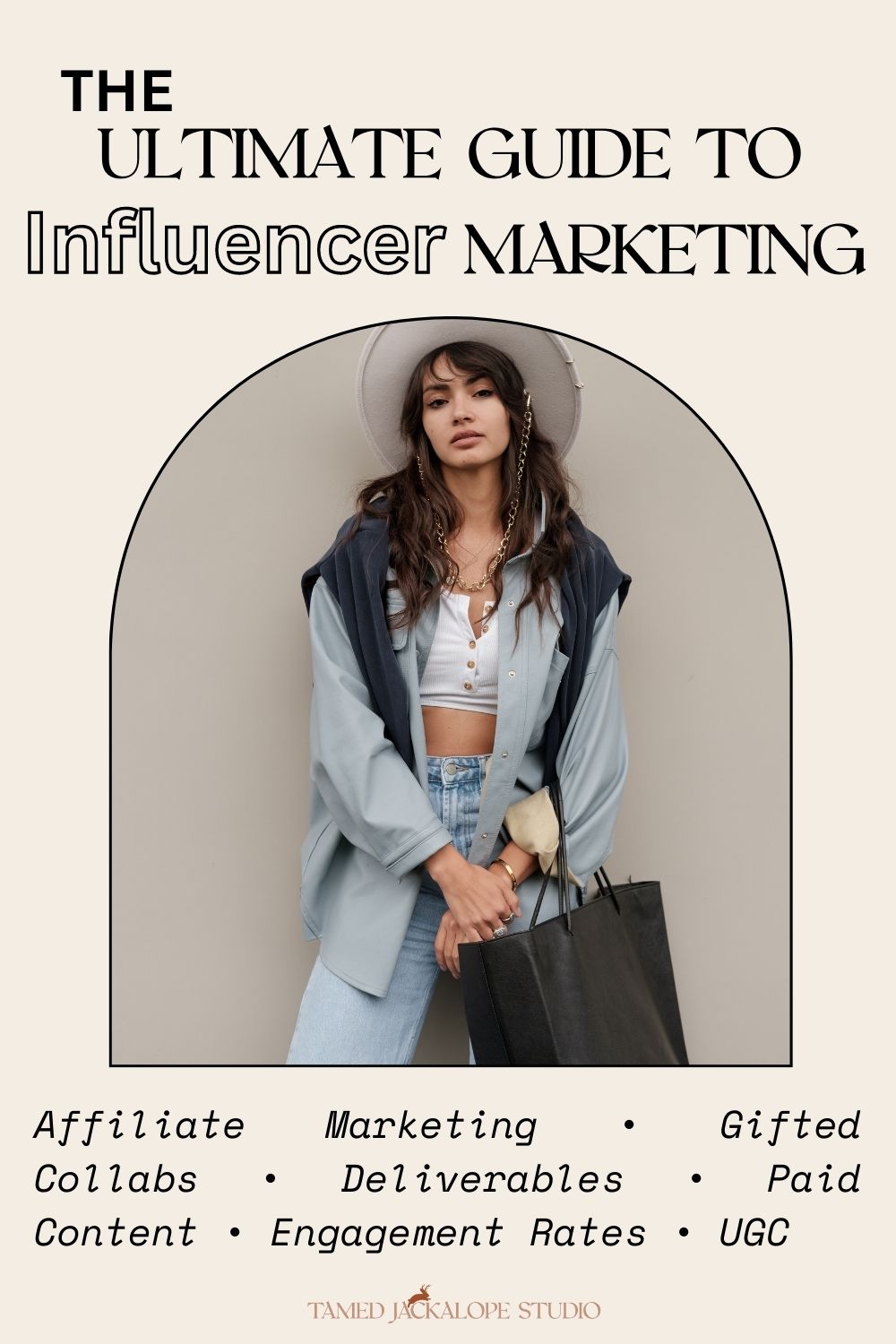Download Now
Start Growing your email list with dream leads
The CEO and creative director at Tamed Jackalope Studio, a strategic design studio for service providers
I'm Shelby
Welcome to the Blog
The Ultimate Guide to Influencer Marketing
How to Get Started and Grow Your Brand

In 2023 I think almost everyone has heard of Influencer Marketing. It’s easy to tell yourself that influencer marketing doesn’t apply to your business or that you need to have X amount of followers or X amount of marketing budget before you can reach out to influencers but that’s not true!
As many as 91% of businesses that responded to a survey from Influencer Marketing Hub had used influencer marketing in some form in 2020. (Source: Influencer Marketing Hub) And that was 2020!
Influencer marketing continues to be an effective marketing strategy that is especially applicable to businesses in the online world. Don’t believe me? The proof is in the pudding.
- According to a survey by Influencer Marketing Hub, 89% of marketers find influencer marketing to be an effective strategy, with 65% planning to increase their budgets for it in the coming year. (Source: Influencer Marketing Hub)
- A study by SocialPubli found that 84% of consumers make purchases after seeing a product or service recommended by an influencer. (Source: SocialPubli)
- Another study by Mediakix revealed that businesses make an average of $5.20 for every dollar spent on influencer marketing, with top-performing campaigns earning as much as $18 per dollar invested. (Source: Mediakix)
- A survey by Rakuten Marketing found that 38% of consumers are more likely to trust a brand if it is recommended by an influencer, and 80% of consumers have made a purchase based on an influencer’s recommendation. (Source: Rakuten Marketing)
It’s no secret that influencers have a huge impact on the buying decisions of their followers, and if you’re looking to grow your business, it’s time to hop on the bandwagon.
So what makes Influencer Marketing so effective?
Generally speaking, two things happen when a consumer sees influencer content that promotes a product/service.
- It feels like they are getting a personal referral from a friend. Personal recommendations are one of the HIGHEST converting marketing strategies EVER. The trust that the recommend-or (is that a word? It is now.) has for the brand or product is automatically transferred to recommend-ee (another new word for us all to try). Influencer marketing is not quite as highly converting as true word of mouth marketing but it invokes the same feelings and the more that a consumer relates to the influencer the more they will trust their recommendations.
- It creates good old FOMO. FOMO (Fear Of Missing Out) is a powerful emotion! Anyone who has spent more than an hour on an app like Instagram knows that social media is often a highlight reel. Beautifully aesthetic playrooms, clean kitchens with the latest appliances, taking vacations to the most beautiful corners of the world, and even their dog seems to be better groomed and behaved than yours! This “highlight reel” effect creates a sense of aspiration as well as envy and will lead buyers to an emotional decision about purchasing a product. “She has such great skin, if she uses that skin cream then I should too!”
What are the different types of Influencer Marketing?
There are a few different strategies and terms that you should know about before you begin your influencer marketing campaign.
- Micro – Macro – Mega Influencers
The differences between micro, macro, and mega influencers are exactly what they sound like. They are influencers of different sizes.
- Micro influencers – less than 10,000 followers
- Macro influencers – between 10,000 – 200,000 followers
- Mega Influencers – 200,000 – 1,000,000+
Influencers with follower counts of 20,000 or more will almost always require upfront payment (creators with less than 20K may also require upfront payment)
2. Gifting
Smaller influencers will often work on a “gifting” collaboration. That means that they will post content about your product in exchange for free product. This is an extremely cost effective strategy for spreading awareness and gaining UGC or user generated content.
When working with gifted collaborations you may experience more “ghosting” especially when you’re a smaller or lesser-known brand. So calculate a certain % of loss when working on this type of campaign.
3. Paid Collaboration
Creators with a bigger or more engaged following may automatically require a payment for their collaboration. Rates vary greatly across the industry. Influencer A with 25K followers and a 7% engagement rate may only charge $200 per post where Influencer B with 20K followers and a 2% engagement rate charge $2,000 for a post.
Generally speaking these rates may be negotiable and can change over time. For example the holiday season is especially busy and creators may be flooded with offers from large corporate brands, therefor less likely to spend time on gifted collabs or low paying jobs, however Q2 may be slower for some creators making it a good time to negotiate.
4. Affiliate Program
Affiliate programs are one of my absolute favorite campaigns to run. In an affiliate program, influencers earn a commission on every sale that comes from their recommendation or promotion. This is often done through a custom coupon code or unique tracking link. They often work hand in hand with gifted collabs and make a great negotiating factor when your budget is low.
For example, let’s say you want to work with Influencer A from the earlier example. They are asking for $200 in exchange for 1 main feed post and 2 Instagram stories. By offering them an affiliate code with a 20% commission, if 3% of their audience buys your $30 product (at 20% commission they would earn about $6 per sale) they can earn $4,500! P.S You have also brought in $22,500 in revenue by the way.
The best part of this campaign style is that it is often self-motivating for the influencer, they can’t get paid if they don’t promote. You also don’t pay upfront! You can pay their share of the sale after the order has cleared and been shipped making it one of the easiest ways to pitch larger creators with little to no marketing budget.
There are several great Affiliate software options out there to automate sale tracking and payments. If you’re using Shopify then Shopify Collabs is an awesome (and free) tool. UpPromote is also a great option.
5. Engagement
Never be fooled by a large following count! Engagement is just as (if not more) important than follower count! What good does it do to promote to 50K followers if less than 1% of them engage with the creator?
High engagement is a sign that the creator not only knows what they’re doing, best practices for social media etc, but that they have a good relationship with their followers (and we want it to feel like our products are being recommended by a friend remember?)
The average engagement rate for Instagram accounts with 100K or less followers is 2.4% (engagement rates generally drop as follower count rises)
6. Deliverables
Deliverables are the exact things the influencer is agreeing to do for you in this collaboration. This could include specific things like:
- Reviews
- Posts
- A set number of images
- Video content (reels, TikTok, Youtube)
7. UGC User Generated Content
UGC is another great reason to work with creators even if the creator does not convert sales. Video reviews or tutorials that are created by real people where they freely give their honest opinion in their own words are some of the biggest converting assets your business can have.
Paid UGC can cost as much as $500+ so working with gifted collabs or affiliate programs is a very cost-effective way to get that UGC that you can then repost and share on your own socials and use in your website either through a review section or directly in your product description.
Are you convinced yet that this can work for your business?
Lets walk through how to set up your first influencer marketing campaign.
- Define your goals
Before you start reaching out to influencers, it’s important to define your goals. What do you want to achieve through this campaign? Do you want to increase brand awareness, drive sales, or both? Knowing your goals will help you determine the type of influencers you want to work with and the metrics you’ll use to measure success.
- Find the right influencers
The next step is finding the right influencers for your brand. You want to work with influencers who align with your brand values and have an engaged following. Start by researching influencers in your industry and look at their engagement rates, content quality, and audience demographics. HINT your follower list is a good place to start!
- Reach out to influencers
Once you’ve identified potential influencers, it’s time to reach out to them. Keep in mind that influencers receive a lot of partnership requests, so make sure your outreach is personalized and stands out. Be clear about your goals and what you offer in exchange for their service.
Do NOT send out mass emails that have no personalization. While it is time effective to use a general template make sure to take the time to compliment their style, accomplishments, or note how well they did on another recent collaboration.
- Set clear expectations
Once you’ve found the right influencers and they’ve agreed to work with you, it’s important to set clear expectations. Be clear about the deliverables, timelines, and compensation. Make sure both parties are on the same page to avoid any misunderstandings. Consider drafting up a contract when doing paid collabs.
- Measure success
Finally, it’s important to measure the success of your influencer marketing campaign. Use the metrics you defined in step one to track the impact of the campaign. This will help you identify what worked and what didn’t, and adjust your strategy for future campaigns.
Wohoo! You’re a pro now at this influencer marketing thing! Take what you’ve learned today and put it in action.
This post may contain affiliate links
Recent Posts on the Blog
Is your brand actually doing anything?
Test your brand
Take the brand assessment quiz to find out.


